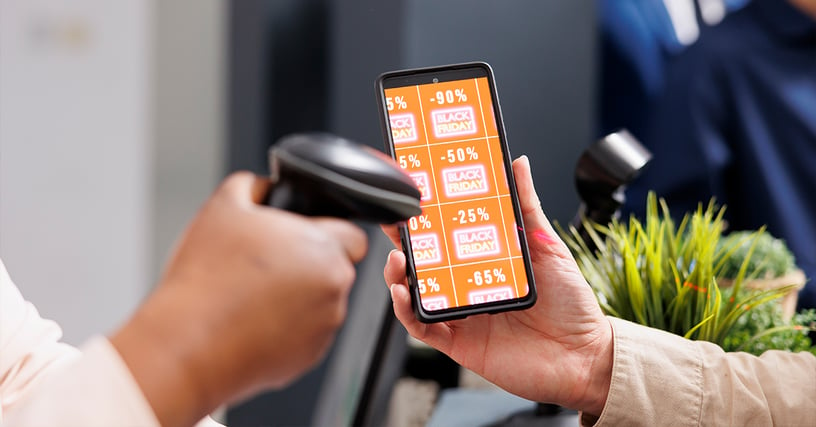Every retailer can pilot IoT—but scaling requires treating transformation as business evolution, not just technology deployment.

Retail Can’t Afford to Treat IoT as Optional
Digital transformation in retail is no longer optional; it's table stakes. From streamlining inventory and reducing waste to powering real-time pricing and improving sustainability, the Internet of Things (IoT) promises a smarter, more responsive store. And yet, most retailers can't get past the pilot phase.
Why?
Not because the technology isn't ready. Because retailers aren't scaling-ready.
While sensors, electronic shelf labels (ESLs), and AI-powered shelf vision technologies are proven in isolated deployments, they hit a wall when retailers attempt enterprise-wide rollouts. The core issue isn't the tools. It's the mindset. Or more precisely, a lack of a scaling mindset.
Let's unpack that.
How IoT Transforms Retail Store Operations
For executives navigating digital transformation, IoT in retail represents a fundamental shift from reactive to proactive operations. At its core, IoT creates a network of connected devices that provide real-time insights and automate routine decisions across the retail ecosystem.
- Electronic shelf labels replace manual price changes with instant updates across thousands of locations, eliminating errors and reducing labor costs
- Smart inventory sensors detect product levels automatically and trigger reordering before stockouts occur, optimizing availability without overstock
- Computer vision systems analyze customer behavior, product performance, and operational efficiency without human intervention
The transformative power emerges when these components work together as an integrated system. A customer interaction triggers inventory updates, which influence pricing algorithms, which inform procurement decisions, all happening in real-time without manual intervention. This level of operational sophistication is what separates market leaders from followers in today's retail landscape.
The Industry-Wide Scaling Crisis
Across the board, retailers are investing in digital tools, but they're struggling to take those tools beyond the test environment.
Incisiv research finds that while a majority of retail organizations feel confident in their current digital capabilities, only 13% believe their customer-facing technologies are prepared to meet future expectations. That’s a signal of growing urgency: the gap between current performance and future demand is widening.
What’s more, according to Incisiv, 89% of retailers say they struggle to scale new technologies across the organization. It's not because the tech doesn't work; it's because most organizations haven't built the processes, measurements, or internal alignment to support widespread rollout. The result? Valuable tools sit in limbo while frontline teams remain disconnected from innovation. The scaling problem isn't technical. It's operational.
Why Most IoT Pilots Never Reach Enterprise Scale
Many IoT pilots are successful in demonstrating value, but few make it to full-scale deployment. The problem lies not in the pilot itself, but in the conditions surrounding it.
- Fragmented Ownership: Pilots often sit within one team (IT, innovation, or store ops) without clear pathways for cross-functional integration.
- Lack of Change Management: New technologies aren’t paired with training, process redesign, or incentives to encourage adoption.
- No Scaling Blueprint: Even when pilots show measurable results, there's no roadmap to take them beyond the initial environment.
This creates a loop of repeated testing with limited learning. A pilot may save hours per week or improve inventory accuracy, but without a structured plan for scaling, those wins remain anecdotal. Over time, pilot fatigue sets in, and innovation stalls.
To break the cycle, IoT programs must be architected for scale from day one, with executive sponsorship, measurable outcomes, and a shared understanding of what success looks like across the business.
The Measurement and Investment Gap
Scaling IoT isn't just about deploying more devices. It's about making a compelling case for why those devices matter financially, operationally, and strategically.
Unfortunately, many retailers struggle to quantify the impact of their tech investments. According to Incisiv, only 17% of organizations say they can effectively measure the savings from their technology deployments. And when savings are realized, they’re rarely used to fund further innovation.
This lack of visibility creates friction with finance teams and slows momentum. It also makes it difficult to prioritize scaling initiatives amid competing budget demands.
To change the narrative, retailers need to measure impact across multiple dimensions:
- Labor productivity
- Operational uptime
- Shrink and loss prevention
- Revenue lift from improved availability and pricing
- ESG benefits, such as waste reduction and energy efficiency
Quantifying value isn't just about validating past investments. It's about securing future ones and making IoT a repeatable, fundable part of enterprise growth.
The Business Case: What IoT Delivers When Done Right
While measurement challenges persist across the industry, retailers who successfully quantify IoT impact consistently see benefits that extend far beyond operational efficiency. The key is understanding that IoT transformation creates value across multiple business dimensions simultaneously.
- Operational excellence through reduced manual tasks, improved inventory accuracy, and streamlined processes that free staff to focus on customer-facing activities
- Revenue optimization via dynamic pricing capabilities, reduced stockouts, and enhanced product availability that directly impact sales performance
- Customer experience enhancement through faster service, accurate information, and seamless interactions that drive loyalty and repeat business
- Sustainability leadership by minimizing waste, optimizing energy consumption, and supporting ESG objectives that increasingly influence brand perception and regulatory compliance
The most compelling business cases emerge when these benefits compound over time, creating sustainable competitive advantages that become increasingly difficult for competitors to match. This multiplier effect is what transforms IoT from a cost center into a strategic growth driver.
What Enterprise-Scale IoT Success Requires
So what does it take to move from experiment to enterprise? Scaling IoT successfully demands more than just technological readiness; it requires operational maturity and a mindset that integrates digital capabilities into every layer of the business. At the core, there are three enterprise disciplines that define whether connected store initiatives remain pilots or become permanent enablers of performance.
- Cross-functional ownership is the first and arguably most important requirement. IoT cannot be championed by a single department; it must be co-owned across store operations, IT, merchandising, and sustainability. These teams must align early in the process, defining shared KPIs and accountability structures that keep the program focused on enterprise goals. Without a clear governance model to manage rollout at scale, even well-performing pilots will struggle to gain traction beyond a handful of stores.
- Value-driven measurement is equally critical. Retailers must look beyond traditional cost metrics to quantify the broader impact of IoT, from service level improvements to inventory accuracy, labor productivity, and customer experience gains. These impacts should be measured consistently across stores, enabling leadership to identify patterns, iterate, and scale based on real-world insights. Early rollouts should serve not just as functional tests, but as data-generating engines that validate the business case and support strategic decision-making.
- Sustainability integration is the third discipline, and one that is becoming increasingly vital in retail boardrooms. Connecting IoT programs to ESG objectives not only helps justify investment but also aligns transformation with brand purpose and regulatory requirements. Whether it's reducing energy consumption, minimizing food waste, or shrinking packaging and emissions footprints, the environmental impact of IoT deployments should be measured, communicated, and built into long-term roadmaps. Doing so elevates IoT from an operational tool to a strategic asset that supports both profit and planet.
Organizations that prioritize these three disciplines (ownership, measurement, and sustainability) are more likely to convert innovation into lasting enterprise value. At that point, scaling becomes less about the technology itself, and more about disciplined execution, aligned incentives, and consistent leadership.
Retail’s Mindset Shift Must Begin Now
The future of physical retail depends not on new technology, but on a new mindset. It's no longer enough to pilot innovation. To meet rising customer expectations and internal performance goals, IoT must be woven into the everyday fabric of retail operations.
This shift will require more than capital investment. It will demand cross-functional trust, disciplined measurement, and a long-term commitment to scale. Organizations that embrace this mindset will be better equipped to adapt, compete, and grow, even in uncertain times.
As NRF 2026 approaches, the question isn't whether retail is transforming; it's how effectively that transformation is being operationalized. The most impactful changes won't be found in isolated experiments. They'll be seen in the day-to-day execution of digital strategies across every store, region, and function.
And that's the difference between innovation that inspires and innovation that delivers.





